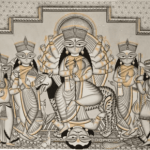
Srinagar has a long tradition of crafts and folk arts, with skills passed down from generation to generation. One of the most popular crafts of Srinagar is papier-mâché, a technique of making decorative objects using paper pulp.
Art is not what you see, but what you make others see.
Edgar Degas


Before the 1911 theft of the “Mona Lisa” painting from the Louvre Museum in Paris, it was well-known and highly regarded, but it was not as famous as it is today. The painting was painted by Leonardo da Vinci in the early 16th century and was owned by King Francis I of France, who was a major patron of the arts. However, it was not until the theft and subsequent widespread media coverage that the painting became a global sensation and one of the most famous works of art in the world. The theft and subsequent investigation brought the painting to the forefront of public attention and helped to establish its iconic status.
Vincent van Gogh died poor. Despite having a passion for art, he struggled to make a living from his work during his lifetime. He could never sell a painting during his lifetime for a high price. In fact, he sold only a small number of paintings, and most of them were sold for relatively modest sums. The highest price that is known to have been paid for one of his paintings during his lifetime was 400 francs for “The Red Vineyard,” which was sold to Anna Boch, a Belgian painter and collector.
However after his death, the value of van Gogh’s paintings has increased significantly and now fetch hundreds of millions of dollars at auction. In 2017, his “Painting, Wheat Field with Cypresses” sold for a record-breaking $82.5 million at a Christie’s auction in New York.
One of the main reasons for later fame was the interest and support of his brother, Theo van Gogh, who was an art dealer. Theo promoted Vincent’s work after his death, and helped to organize exhibitions of his paintings. Additionally, the art community and critics eventually began to recognize the unique style and significant contributions of Vincent van Gogh to the post-impressionist movement. As a result, his paintings and drawings gained popularity and his reputation as an artist grew. Today, he is widely regarded as one of the greatest artists of all time, and his works are some of the most valuable and highly sought after in the world.
A painting can be considered expensive for several reasons such as:
Rarity and uniqueness – A painting that is one-of-a-kind, has historical or cultural significance, or was created by a famous artist is likely to be expensive. As mentioned above, Monalisa is one such example.
Artist’s reputation – Paintings by well-established and renowned artists tend to command high prices, especially if they have a history of selling their work for significant amounts. Some of the reputed names are Vincent van Gogh, Salvador Dali, Leonardo da Vinci, Rembrandt, Pablo Picasso among many. Raja Ravi Varma, Abanindranath Tagore, Nandalal Bose, M. F. Husain are some of the names from India.
Condition – Paintings that are in excellent condition and have been well-maintained over time are more valuable than those that have been damaged or are in poor condition.
Supply-Demand – High demand for a particular artist or style of painting can drive up prices. At times when an artist dies, it drives up the price. The artist’s death leads to a situation when only a finite number of their work exists. This creates a supply constraint. And this is not uncommon for the world to take note of things when it ceases to exist.
Size – Larger paintings typically sell for more than smaller ones, all else being equal. Large size paintings also need higher skill level to execute them. Artist Emad Salehi created a new world record for the largest art canvas measuring at 9,652 m² (103,893 ft² 37 in²) in Doha, Qatar. The artwork is called “The story of the ball”.
Provenance – Paintings with a documented history of ownership, exhibitions, and previous sales can be more valuable than those with little to no provenance.
Image credit

Srinagar has a long tradition of crafts and folk arts, with skills passed down from generation to generation. One of the most popular crafts of Srinagar is papier-mâché, a technique of making decorative objects using paper pulp.

Bengali Patachitra, a traditional form of scroll painting hailing from the eastern Indian state of West Bengal, is a captivating world of art that tells stories, legends, and myths through vibrant visuals. Patachitra, derived from the Bengali words “pata” (cloth or canvas) and “Chitra” (picture), is an art form deeply rooted in the cultural heritage of Bengal. In this blog, we will take a colourful journey into the fascinating world of Bengali Patachitra, exploring its history, techniques, themes, and cultural significance.

Welcome to the world of art investing!
Imagine owning a piece of history, a tangible expression of human creativity, and an asset that is potentially appreciated over time. Contrary to popular belief, investing in art isn’t just for the ultra-wealthy. With the right knowledge and guidance, anyone can become a discerning art collector.